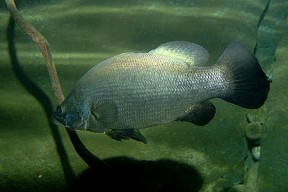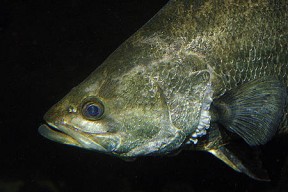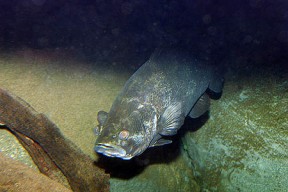Lates niloticus
Nile Perch
Classification
Latidae
Distribution
Widespread throughout much of Central and Western Africa, where it inhabits all the major rivers, including the Nile, Chad, Senegal, Volta and Congo. It’s present in many major lakes including Lake Victoria, and has been introduced into many African countries as it’s an excellent table fish.
Habitat
Lakes, rivers and canals. It can also withstand brackish conditions, with a population thriving in the saline Egyptian lake of Mariout.
Maximum Standard Length
Among the world’s largest freshwater species at 77.2″ (193cm), and up to 200kg in weight.
Aquarium SizeTop ↑
A truly enormous tank (or pond) would be required by an adult specimen. Something in the region of 20′ x 6′ x 10′ would be considered a bare minimum. A tank like this would hold over 30,000 litres of water!
Maintenance
Speaking hypothetically, decor would not be critical. Obviously, an enormous filtration system would be needed to cope with the massive amounts of biological waste a fish like this produces.
Water Conditions
Temperature: 72-82°F (22-28°C)
pH: 7.0-8.5
Hardness: 10-30°H
Diet
Highly piscivorous in nature, juvenile captive specimens have been known to accept prawns, lancefish etc. An adult fish would need large amounts of whole fish such as trout. Keeping one of these fully fed would certainly be an expensive proposition. Larger specimens should be fed with care as they tend to strike quite savagely when feeding.
Behaviour and CompatibilityTop ↑
Peaceful with anything it can’t fit into its mouth. This doesn’t actually leave many species that it can be housed with in the long term though. Young specimens have been successfully cohabited with tankmates such as Cichla sp., Datnioides sp., arowana and tankbusting catfish.
Sexual Dimorphism
Unknown.
Reproduction
Surely impossible in aquaria.
NotesTop ↑
This species has been introduced into many areas in Africa for commercial purposes, and it’s had a hugely detrimental effect on local fish populations in some of these environments. The most notable case is that of Lake Victoria, where much of the endemic cichlid population has been wiped out. L. niloticus is thought to have directly contributed to the extinction of over 200 endemic species in the lake by predation, or outcompeting them for food. The IUCN have included it in their list of the world’s top 100 invasive species.
It’s included here because there have been an alarming number of juvenile fish showing up recently in some aquatic stores and, as a result, in hobbyists tanks. This fish is simply not suited to captive life in any respect. To know that it’s one of the most sought after sport fish in Africa should tell you all you need to know about it. Although undeniably attractive when juvenile, please don’t be tempted to buy if you see these for sale. Housing one for life is beyond the reach of even most public aquaria. Sadly owning this species and others like it seems to be fashionable in some fishkeeping circles at the moment, with some aquarists even viewing them as a status symbol. We can only hope this situation can be rectified in the future, as surely all these aquarium specimens are doomed to a premature death.




